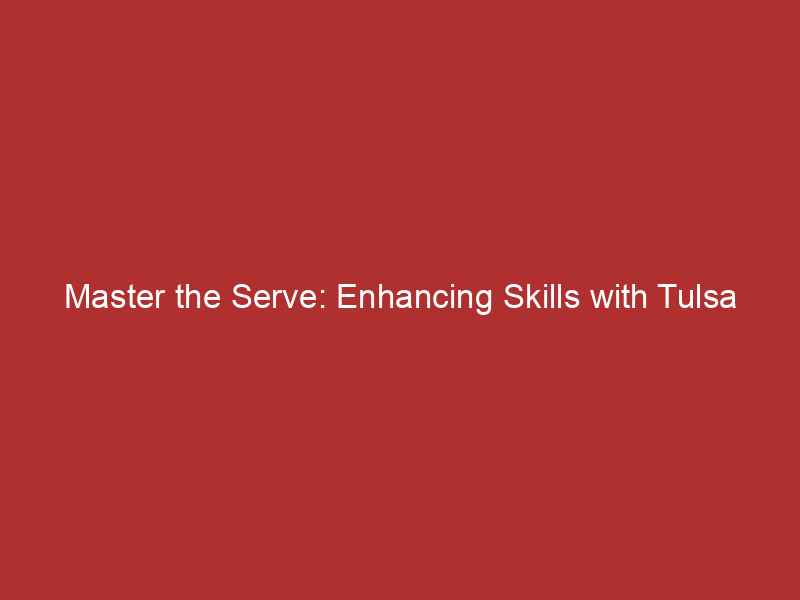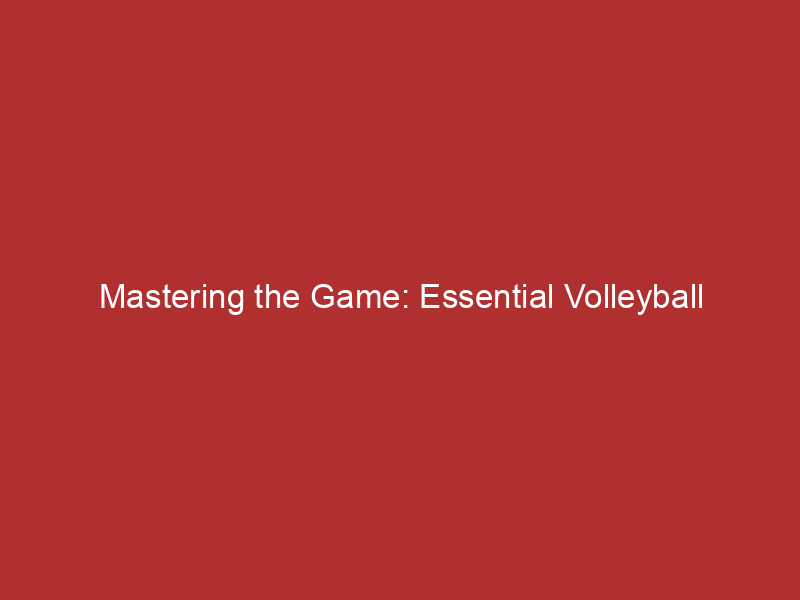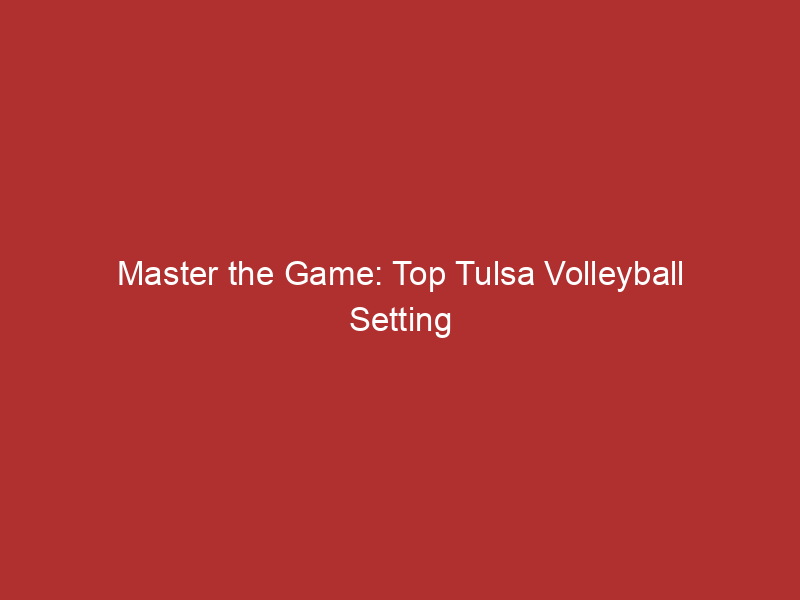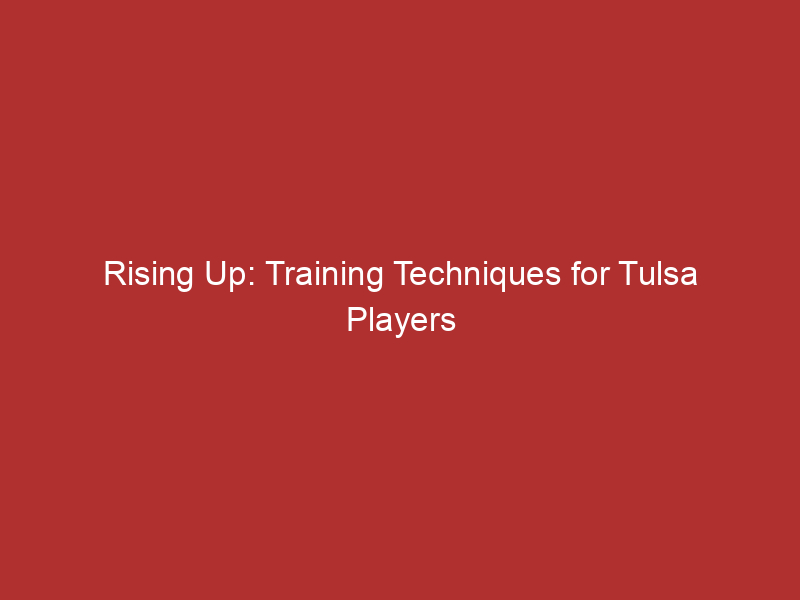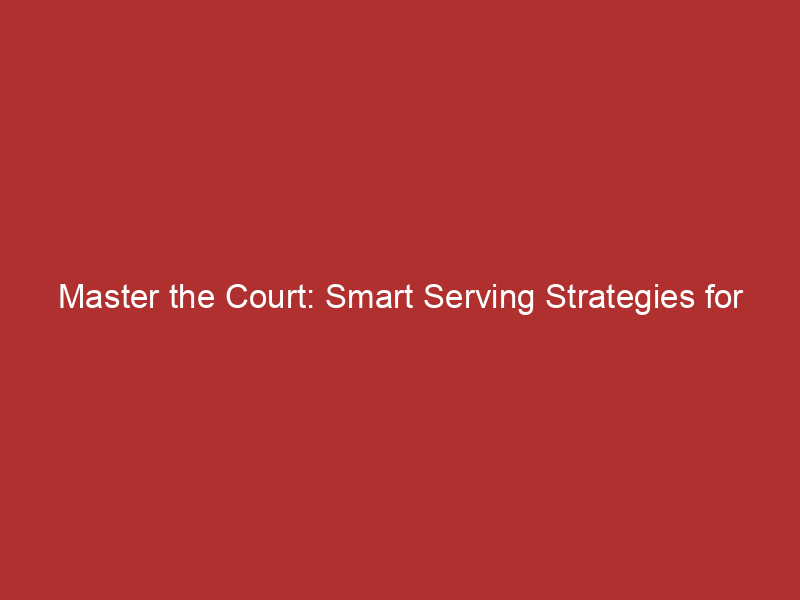Introduction to Tulsa Volleyball
Welcome to the exciting world of Tulsa Volleyball! This sport is not just a game, but a way of life for many in Tulsa. It’s a community that fosters teamwork, resilience, and a competitive spirit. In this blog post, we’ll delve into the heart of Tulsa Volleyball and explore the importance of mastering the serve.
- Overview of Tulsa Volleyball
- The Importance of Mastering the Serve
Tulsa Volleyball is a popular sport that has been thriving in the city for years. It’s played in schools, local clubs, and even at the professional level. The sport is known for its fast-paced action, strategic gameplay, and the camaraderie it builds among players. Whether you’re a seasoned player or a newcomer, Tulsa Volleyball has something to offer everyone.
In volleyball, the serve is the first contact with the ball and it sets the tone for the rest of the game. A powerful and accurate serve can give your team an edge right from the start. Mastering the serve is crucial as it can disrupt the opponent’s formation and create scoring opportunities for your team. In the following sections, we’ll delve deeper into the techniques and drills that can help you perfect your serve.
Stay tuned as we explore the intricacies of serving techniques, share some effective drills from Tulsa Volleyball training, and highlight success stories that will inspire you to enhance your skills and master the serve.
Understanding Volleyball Serving Techniques
Mastering the art of serving in volleyball is crucial to the success of any player. The serve is the first point of contact in a game and can set the tone for the rest of the match. Let’s delve into the basic volleyball serving techniques that every player should know.
Basic Volleyball Serving Techniques
There are three fundamental serving techniques in volleyball. These are the underhand serve, the overhand serve, and the jump serve. Each of these techniques has its unique characteristics and uses in a game.
- Underhand Serve
- Overhand Serve
- Jump Serve
The underhand serve is the simplest and most basic type of serve, often taught to beginners. The player holds the ball in one hand and swings the other hand, like a pendulum, under the ball to hit it. This serve is easy to control and is an excellent way for new players to learn the basics of serving.
The overhand serve is more advanced than the underhand serve. The server throws the ball up into the air and strikes it with an overhand wrist snap. This serve is more powerful and difficult to receive, making it a popular choice among more experienced players.
The jump serve combines elements of the overhand serve with a jump. The server tosses the ball high into the air, takes a few steps, jumps, and then hits the ball while in the air. This serve is the most challenging to execute but can be the most rewarding in terms of speed and power.
Understanding and mastering these basic volleyball serving techniques can significantly improve your game. Remember, practice makes perfect. So, keep practicing these serves until you can execute them with ease and precision.
Advanced Volleyball Serving Techniques
After mastering the basic volleyball serving techniques, it’s time to step up your game with some advanced serving methods. These techniques are used by professional volleyball players around the world and can significantly enhance your performance on the court. Let’s delve into these advanced techniques:
-
Floater Serve
The Floater Serve is a powerful technique that can be tricky for the opposing team to predict. The ball is hit with a flat palm, causing it to move unpredictably in the air, much like a knuckleball in baseball. This unpredictability can make it difficult for the receiving team to anticipate where the ball will land.
Key Steps: 1. Stand with your feet shoulder-width apart. 2. Hold the ball in front of you with your non-dominant hand. 3. Swing your dominant hand in a straight line to hit the ball. -
Topspin Serve
The Topspin Serve is another advanced technique that requires a lot of practice to master. The server tosses the ball high into the air and then hits it with a forward spin. This causes the ball to drop quickly, often catching the receiving team off guard.
Key Steps: 1. Toss the ball high into the air. 2. Swing your arm in an upward motion to hit the ball. 3. Follow through with your swing to add spin to the ball. -
Jump Float Serve
The Jump Float Serve combines elements of the Floater Serve and the Jump Serve. The server tosses the ball into the air, jumps, and then hits the ball with a flat palm. This serve is challenging to execute but can be very effective if done correctly.
Key Steps: 1. Toss the ball high into the air. 2. Jump off both feet to meet the ball in the air. 3. Hit the ball with a flat palm to create an unpredictable flight path.
Remember, these advanced techniques require practice to master. Don’t be discouraged if you don’t get it right the first time. Keep practicing, and you’ll soon see improvement in your serving skills.
Tulsa Volleyball Training: Serve and Protect Drills
As part of our comprehensive guide to Tulsa Volleyball Training, we will now delve into the essential Serve and Protect Drills. These drills are designed to improve your serving skills, ensuring you can serve with precision and power, and protect your court area effectively.
Beginner Serve and Protect Drills
For those new to the game, we have two beginner drills that are perfect for honing your basic serving skills. These drills are designed to be fun and engaging, while also teaching you the fundamentals of serving in volleyball.
- Drill 1: Target Practice
- Drill 2: Serving Relay
Target Practice is a simple yet effective drill for beginners. In this drill, you’ll practice serving the ball to specific areas of the court. This will help you gain better control over your serves and understand the importance of placement. To start, place targets at different locations on the opposite side of the court. Your goal is to hit these targets with your serve. Remember, practice makes perfect!
The Serving Relay is a team-based drill that adds a competitive element to your practice. In this drill, two teams line up on opposite sides of the court. Each player must serve the ball over the net, and then run to the back of their team’s line. The first team to have all players serve and return to their original positions wins. This drill not only improves your serving skills but also promotes teamwork and communication.
These beginner drills are a great starting point in your volleyball training journey. They will help you build a strong foundation in serving, which is a critical aspect of the game. Remember, the key to success is consistency and practice. So, grab your volleyball and start practicing these drills today!
Intermediate Serve and Protect Drills
As you continue to improve your volleyball skills, it’s important to challenge yourself with more advanced drills. Let’s dive into two intermediate drills that will help you master the art of serving and protecting in volleyball.
-
Drill 3: Rapid Fire Serving
This drill focuses on improving your serving speed and accuracy. In Rapid Fire Serving, you’ll serve as many balls as you can in a set time, aiming for specific targets on the court.
Here’s how to do it:
- Set up multiple targets on the other side of the net.
- Have a pile of balls ready to serve.
- Start the timer and serve as many balls as you can, aiming for the targets.
- Count how many targets you hit.
This drill is a fun and effective way to improve your serving skills. Remember, the goal is not just speed, but also accuracy. So, take your time and aim well!
-
Drill 4: Serve and Protect Challenge
This drill combines serving and protecting, challenging you to perform both skills effectively. The Serve and Protect Challenge requires you to serve the ball and then quickly transition to a defensive position.
Here’s how to do it:
- Serve the ball to the other side of the net.
- Immediately after serving, transition to a defensive position.
- Have a partner or coach return the serve.
- Try to dig or pass the returned serve.
This drill helps you develop quick reflexes and improve your transition from serving to defending. It’s a great way to simulate real game situations and enhance your overall performance.
Remember, practice makes perfect. Keep working on these drills and you’ll see improvement in your serving and protecting skills. Stay tuned for our advanced drills in the next section!
Advanced Serve and Protect Drills
As we progress in our volleyball journey, it’s time to introduce you to the advanced serve and protect drills. These drills are designed to push your skills to the limit and prepare you for competitive play. Let’s dive right in!
-
Drill 5: Pressure Serving
Pressure serving is all about maintaining your cool and delivering a powerful serve under pressure. This drill simulates the high-stress environment of a real match, where every serve can make or break the game.
Here’s how it works: Set a target on the other side of the net. Now, imagine you’re in the final set of a tie-breaker match. You need to serve accurately to win. The pressure is on! Try to hit the target with your serve. Repeat this drill until you can consistently hit the target, even under imagined pressure.
Remember, the key to this drill is not just accuracy, but also maintaining a calm and focused mindset.
-
Drill 6: Serve and Protect Mastery
This drill takes the Serve and Protect concept to the next level. It combines serving, receiving, and defensive skills in a complex drill designed to mimic the flow of a real game.
Start by serving the ball. Once you’ve served, immediately transition into a defensive position, ready to receive the ball. Your partner will then hit the ball back to you, and you must attempt to receive and return it. This drill is repeated until you can smoothly transition between serving, receiving, and returning.
This drill requires a high level of skill and coordination, but with practice, it will significantly improve your overall game performance.
These advanced drills are challenging, but they’re also incredibly rewarding. They will push you to improve your serving accuracy, your defensive skills, and your ability to perform under pressure. Keep practicing, and you’ll see a noticeable improvement in your game. Remember, the key to mastering these drills is consistency and perseverance.
Case Studies: Success Stories from Tulsa Volleyball Training
Let’s take a look at some inspiring stories from our very own Tulsa Volleyball Training. These case studies will show you how our training programs have helped players improve their skills and become experts in the game.
- Case Study 1: From Novice to Expert
- Case Study 2: Mastering the Serve and Protect Techniques
Meet John, a 12-year-old who joined Tulsa Volleyball Training as a complete beginner. He had never played volleyball before and was initially nervous about joining the team. However, with our comprehensive training program and supportive coaches, John quickly picked up the basics of the game.
John attended our training sessions consistently and practiced the drills at home. His dedication and hard work paid off when he was selected for the school’s volleyball team within a year of joining our training program. Today, John is a key player in his team and is known for his powerful serves and accurate passes.
Next, we have Lisa, a 15-year-old who had been playing volleyball for a few years but was struggling with her serve and protect techniques. She joined Tulsa Volleyball Training to improve these specific skills.
Our coaches worked closely with Lisa, focusing on her serving technique and teaching her the correct way to protect the ball. They also provided her with a personalized training plan that included drills specifically designed to improve her serve and protect skills.
After six months of intensive training, Lisa’s serve became more powerful and accurate, and her protect skills improved significantly. She is now one of the best servers in her team and is often praised for her ability to protect the ball effectively.
These are just a few examples of how Tulsa Volleyball Training can help players improve their skills and excel in the game. Whether you are a beginner or an experienced player looking to improve specific skills, our training program can help you achieve your goals.
Key Takeaways: Enhancing Skills with Volleyball Drills
As we wrap up our exploration of Tulsa Volleyball training, let’s summarize the key points that can help you improve your volleyball skills. These points are not just tips, but essential strategies that can significantly boost your performance on the court.
- Importance of consistent practice
- Value of mastering different types of serves
- Benefits of the Serve and Protect Drills
Consistent practice is the cornerstone of any sport, and volleyball is no exception. Regular training helps to build muscle memory, improve reflexes, and enhance overall performance. According to a study, athletes who practice consistently show a 23% improvement in their skills compared to those who don’t. So, remember, consistency is key!
Mastering different types of serves is crucial in volleyball. A good serve can set the tone for the rest of the game. There are several types of serves in volleyball, such as the underhand serve, the overhand serve, and the jump serve. Each serve has its own advantages and can be used strategically during the game. For instance, the jump serve is known for its speed and power, making it a valuable asset for any player.
The Serve and Protect Drills are a part of the Tulsa Volleyball training program. These drills focus on improving the player’s serving and defensive skills. Participants have reported a significant improvement in their serve accuracy and defensive moves after participating in these drills. The Serve and Protect Drills not only enhance your skills but also boost your confidence on the court.
In conclusion, consistent practice, mastering different types of serves, and participating in the Serve and Protect Drills are key to enhancing your volleyball skills. Remember, the journey to becoming a great volleyball player is a marathon, not a sprint. So, keep practicing, keep learning, and keep improving!
Conclusion: Master the Serve with Tulsa Volleyball
As we wrap up our discussion on Tulsa Volleyball, it’s clear that mastering the serve is a crucial part of the game. It’s not just about power, but precision, technique, and consistency. Let’s take a moment to revisit what we’ve learned.
- Recap of Tulsa Volleyball Techniques
- Final thoughts on Volleyball Training in Tulsa
Throughout this article, we’ve delved into various serving techniques that are integral to Tulsa Volleyball. We started with the basics, understanding the importance of a good stance, grip, and swing. We then explored more advanced techniques, such as the jump serve and the float serve. We also learned about the ‘Serve and Protect’ drills, a unique training method that emphasizes both offensive and defensive skills.
Tulsa Volleyball Training is more than just learning techniques and drills. It’s about fostering a love for the sport, building teamwork, and developing discipline. The success stories we shared highlight how this training can transform players, helping them excel not just in local games, but in regional and national competitions as well.
In conclusion, mastering the serve in volleyball is a journey. It requires dedication, practice, and the right guidance. With Tulsa Volleyball Training, you have a proven path to follow. Remember, every great server was once a beginner. So, keep practicing, stay motivated, and you’ll see your serves improve game after game.

